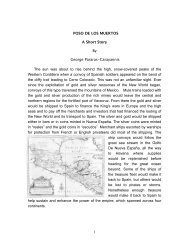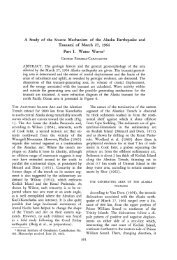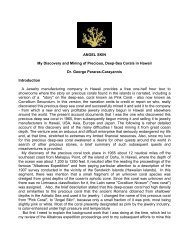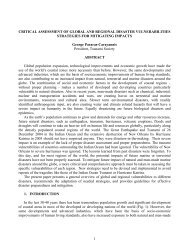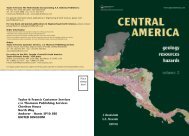TSUNAMI GLOSSARY - Disaster Pages of Dr George, PC
TSUNAMI GLOSSARY - Disaster Pages of Dr George, PC
TSUNAMI GLOSSARY - Disaster Pages of Dr George, PC
You also want an ePaper? Increase the reach of your titles
YUMPU automatically turns print PDFs into web optimized ePapers that Google loves.
Tsunami Glossary Page 8<br />
tsunami propagation Tsunamis travel outward in all directions<br />
from the generating area, with the direction <strong>of</strong><br />
the main energy propagation generally being orthogonal<br />
to the direction <strong>of</strong> the earthquake fracture zone.<br />
Their speed depends on the depth <strong>of</strong> water, so that the<br />
waves undergo accelerations and decelerations in<br />
passing over an ocean bottom <strong>of</strong> varying depth. In the<br />
deep and open ocean, they travel at speeds <strong>of</strong> 500 to<br />
1,000 kilometers per hour (300 to 600 miles per hour).<br />
The distance between successive crests can be as<br />
much as 500 to 650 kilometers (300 to 400 miles);<br />
however, in the open ocean, the height <strong>of</strong> the waves is<br />
generally less than a meter (3 feet) even for the most<br />
destructive teletsunamis, and the waves pass unnoticed.<br />
Variations in tsunami propagation result when<br />
the propagation impulse is stronger in one direction<br />
than in others because <strong>of</strong> the orientation or dimensions<br />
<strong>of</strong> the generating area and where regional bathymetric<br />
and topographic features modify both the wave form<br />
and rate <strong>of</strong> advance. Specifically tsunami waves undergo<br />
a process <strong>of</strong> wave refraction and reflection<br />
throughout their travel. Tsunamis are unique in that<br />
the waveform extends through the entire water column<br />
from sea surface to the ocean bottom. It is this<br />
characteristic that accounts for the great amount <strong>of</strong><br />
energy propagated by a tsunami.<br />
the site <strong>of</strong> an earthquake, volcanic eruption, or landslide<br />
that caused large-scale rapid displacement <strong>of</strong> the<br />
water to initiate the tsunami waves.<br />
tsunamic Having features analogous to those <strong>of</strong> a tsunami<br />
or descriptive <strong>of</strong> a tsunami.<br />
tsunamigenic Having generated a tsunami: a tsunamigenic<br />
earthquake, a tsunamigenic landslide.<br />
tsunami velocity or shallow water velocity The velocity<br />
<strong>of</strong> an ocean wave whose length is sufficiently large<br />
compared to the water depth (i.e., 25 or more times<br />
the depth) can be approximated by the following expression:<br />
c = Sqrt(gh)<br />
Where:<br />
c is the wave velocity<br />
g the acceleration <strong>of</strong> gravity<br />
h the water depth.<br />
Thus, the velocity <strong>of</strong> shallow-water waves is independent<br />
<strong>of</strong> wave length L. In water depths between ½<br />
L and 1/25 L it is necessary to use a more precise expression:<br />
c = Sqrt( (gL/2π)[tanh(2 π h/L)])<br />
10.6Km<br />
213Km<br />
23Km<br />
50m<br />
10m<br />
4000m<br />
Depth<br />
(meters)<br />
Speed<br />
(Km/h)<br />
Wavelength<br />
(Km)<br />
7000 942,9 282<br />
4000 712,7 213<br />
2000 504,2 151<br />
200 159,0 47,7<br />
50 79,0 23,0<br />
10 35,6 10,6<br />
Model <strong>of</strong> the tsunami propagation in the southeast Pacific, nine hours<br />
after its generation. Source: Ant<strong>of</strong>agasta, Chile (30 July, 1995)<br />
tsunami risk The probability <strong>of</strong> a particular coastline being<br />
struck by a tsunami times what is exposed to tsunami<br />
damaged and casualties along that coast. In general<br />
terms, risk is the hazard times the exposure.<br />
tsunami source Point or area <strong>of</strong> tsunami origin, usually<br />
Wave Height and Water Depth: in the open ocean a tsunami is less<br />
than a few feet high at the surface, but its wave height increases rapidly<br />
in shallow water. Tsunami wave energy extends from the surface<br />
to the bottom in the deepest waters. As the tsunami attacks the coastline,<br />
the wave energy is compressed into am much shorter distance<br />
creating destructive, life threatening waves.<br />
tsunami zonation (tsunami zoning) Designation <strong>of</strong> distinctive<br />
zones along coastal areas with varying degrees<br />
<strong>of</strong> tsunami risk and vulnerability for the purpose <strong>of</strong><br />
disaster preparedness, planning, construction codes, or<br />
public evacuation.



